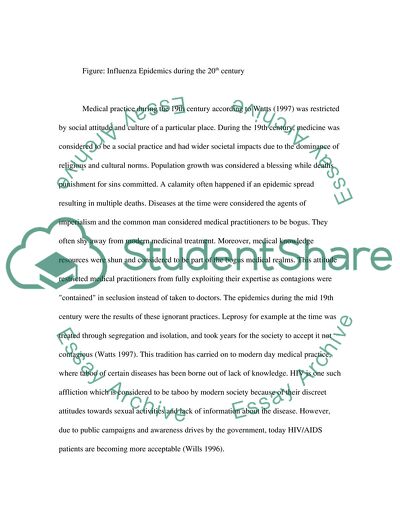
- Home
- Free Samples
- Premium Essays
- Editing Services
- Extra Tools
- Essay Writing Help
- About Us
- Studentshare
- Subjects
- Miscellaneous
- Changing patterns of disese in the UK since the 19th century and simultaneous changes in social and medical attitudes to health issues
Changing patterns of disese in the UK since the 19th century and simultaneous changes in social and medical attitudes to health issues - Essay Example

- Subject: Miscellaneous
- Type: Essay
- Level: Undergraduate
- Pages: 4 (1000 words)
- Downloads: 0
- Author: hgraham
Extract of sample "Changing patterns of disese in the UK since the 19th century and simultaneous changes in social and medical attitudes to health issues"
During the 19th century, medicine was considered to be a social practice and had wider societal impacts due to the dominance of religious and cultural norms. Population growth was considered a blessing while deaths punishment for sins committed. A calamity often happened if an epidemic spread resulting in multiple deaths. Diseases at the time were considered the agents of imperialism and the common man considered medical practitioners to be bogus. They often shy away from modern medicinal treatment.
Moreover, medical knowledge resources were shun and considered to be part of the bogus medical realms. This attitude restricted medical practitioners from fully exploiting their expertise as contagions were "contained" in seclusion instead of taken to doctors. The epidemics during the mid 19th century were the results of these ignorant practices. Leprosy for example at the time was treated through segregation and isolation, and took years for the society to accept it not contagious (Watts 1997).
This tradition has carried on to modern day medical practice, where taboo of certain diseases has been borne out of lack of knowledge. HIV is one such affliction which is considered to be taboo by modern society because of their discreet attitudes towards sexual activities and lack of information about the disease. However, due to public campaigns and awareness drives by the government, today HIV/AIDS patients are becoming more acceptable (Wills 1996). Such privileges were not experienced by the poor people of the 19th century because there was no concept of public health.
Since deaths usually occurred in isolation, it was difficult for medical practitioners to trace the cause of the spread of epidemics as well as ad hoc cases of unknown diseases. Cox (1993) for example noted causes of deaths during the mid 19th century were not indicated except for in ad hoc cases. Exhumation was the only source for studying diseases therefore practitioners too were limited in
...Download file to see next pages Read MoreCHECK THESE SAMPLES OF Changing patterns of disese in the UK since the 19th century and simultaneous changes in social and medical attitudes to health issues
Analyzing Purchase and Consumption Patterns
Attitudes towards homosexuality in the long 19th century
16th Century U.K. Epidemics and its Impact on the British
The History of Medicine in the 17th and 18th Centuries
Sociological Theories of Disability and Chronic Illness
Old Public Health of the 19th Century
Changes in the Concepts of Childhood Since the 19th Century
Designing WSB, Durations, Activities, and Precedence

- TERMS & CONDITIONS
- PRIVACY POLICY
- COOKIES POLICY